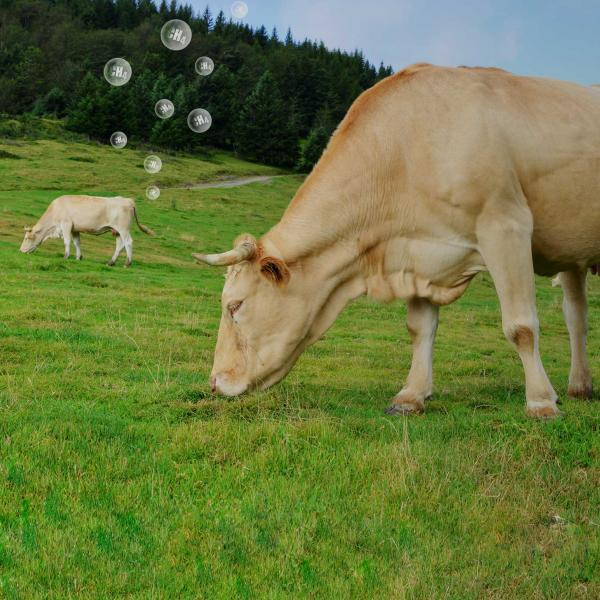With a warming effect that is 80 times greater than carbon dioxide (CO2), cutting methane (CH4) emissions is as Ursula van der Leyen, president of the European commission puts it, “one of the most effective things we can do to reduce near-term global warming”.
Methane emissions account for half of the 1oC rise in average global temperatures since the beginning of industrialisation. The considerable bright side is that methane is relatively short-lived in the atmosphere when compared to CO2, so interventions that reduce methane emissions will have a rapid impact. Alongside decarbonisation of global energy systems towards more sustainable solutions, reducing methane has taken centre-stage in the fight against climate change.
The oil and coal industries, landfill, wildfires, and livestock account for the bulk of anthropogenic (human activity derived) methane emissions. For livestock, cattle belching contributes a surprising 32% of this total, with near 12% of the calorific value of bovine feed being lost in this generation of methane by micro-organisms. Controlling, and reducing these methanogens in the bovine digestive system is a key smart-agriculture approach, which will not only reduce emissions, but also improve cattle productivity in parallel.
Investigation of a range of approaches is currently underway, from the somewhat bizarre belch-capturing bovine masks (https://www.zelp.co/), to bovine feed additives including probiotics, organic acids, seaweed, oils, and fats. Of particular promise is lysozyme, a natural antimicrobial possessing the powerful ability to rupture the protective peptidoglycan coat of gram-positive bacteria. A 2016 Korean study showed a staggering near 50% reduction in methane emissions when lysozyme was incorporated into feed (200g per ton). This could represent a key tool in the global push towards reducing methane emissions from livestock. As the leading producer of lysozyme globally, Bioseutica® is committed to playing its role in the fight against climate change, partly through our use of patented eco-friendly solvent-free production methods for lysozyme.
Use of Lysozyme as a Feed Additive on In vitro Rumen Fermentation and Methane Emission

Lysozyme decreases cattle methane emissions - T1 to T3 show increasing concentrations of lysozyme added to bovine feed, with T3 showing methane emission from condition with 200g/tonne of feed:
The Global Methane Pledge, instigated in September 2021 has set out the goal of reducing methane emissions by 30% by 2030. This carries the potential to prevent over 200,000 premature deaths and over 20m tonnes of crop losses. As of today, over 100 countries have signed up to the pledge, representing half of global anthropogenic methane emissions. COP26 (the UN Climate Change Conference) may have now drawn to a close, but this number continues to increase, with a philanthropic fund pledging over $250m towards these efforts so far. We hope that solutions such as ours will contribute to this push, creating a better future for us all.
Check out this video of NASAs visualisation of global methane release
Learn more about lysozyme here
References
- Biswas et al. 2016 AJAS; Use of Lysozyme as a Feed Additive on In vitro Rumen Fermentation and Methane Emission | Publisher Site
Other References
- Ferraboschi, P.; Ciceri, S.; Grisenti, P. ; Applications of Lysozyme, an Innate Immune Defense Factor, as an Alternative Antibiotic | Publisher Site
- Takada K et al.: Detoxification of lipopolysaccharide (LPS) by egg white lysozyme | Publisher Site
- Tagashira A. et al.: Lysozyme from hen egg white ameliorates lipopolysaccharide-induced systemic inflammation in mice | Publisher Site
- Derde M et al.: Hen Egg White Lysozyme Permeabilizes Escherichia coli Outer and Inner Membranes | Publisher Site
- Derde M et al.: Native lysozyme and dry-heated lysozyme interactions with membrane lipid monolayers: Lateral reorganization of LPS monolayer, model of the Escherichia coli outer membrane | Publisher Site
- Ferrari R.: Antiviral activity of Lysozyme Nature 1959 | Publisher Site
- Lee-Huang S et al.: Lysozyme and RNases as anti-HIV components in beta-core preparations of human chorionic gonadotropin | Publisher Site
- Malaczewska et al.: Antiviral effects of nisin, lysozyme, lactoferrin and their mixtures against bovine viral diarrhoea virus | Publisher Site
- Fukai et al.: New possibilities for egg white lysozyme: heat-denatured lysozyme partially inactivates select foot-and-mouth virus strains | Publisher Site
- Sebaa S. et al.: Dose-dependent effect of lysozyme upon Candida albicans biofilm | Publisher Site
- Samaranayake Y et al.: Antifungal Effects of Lysozyme and Lactoferrin against Genetically Similar, Sequential Candida albicans Isolates from a Human Immunodeficiency Virus-Infected Southern Chinese Cohort | Publisher Site
- Dai, P.; Li, Q.: Lysozyme : Research progress in the application of lysozyme in food and medicine field - A review | Publisher Site


